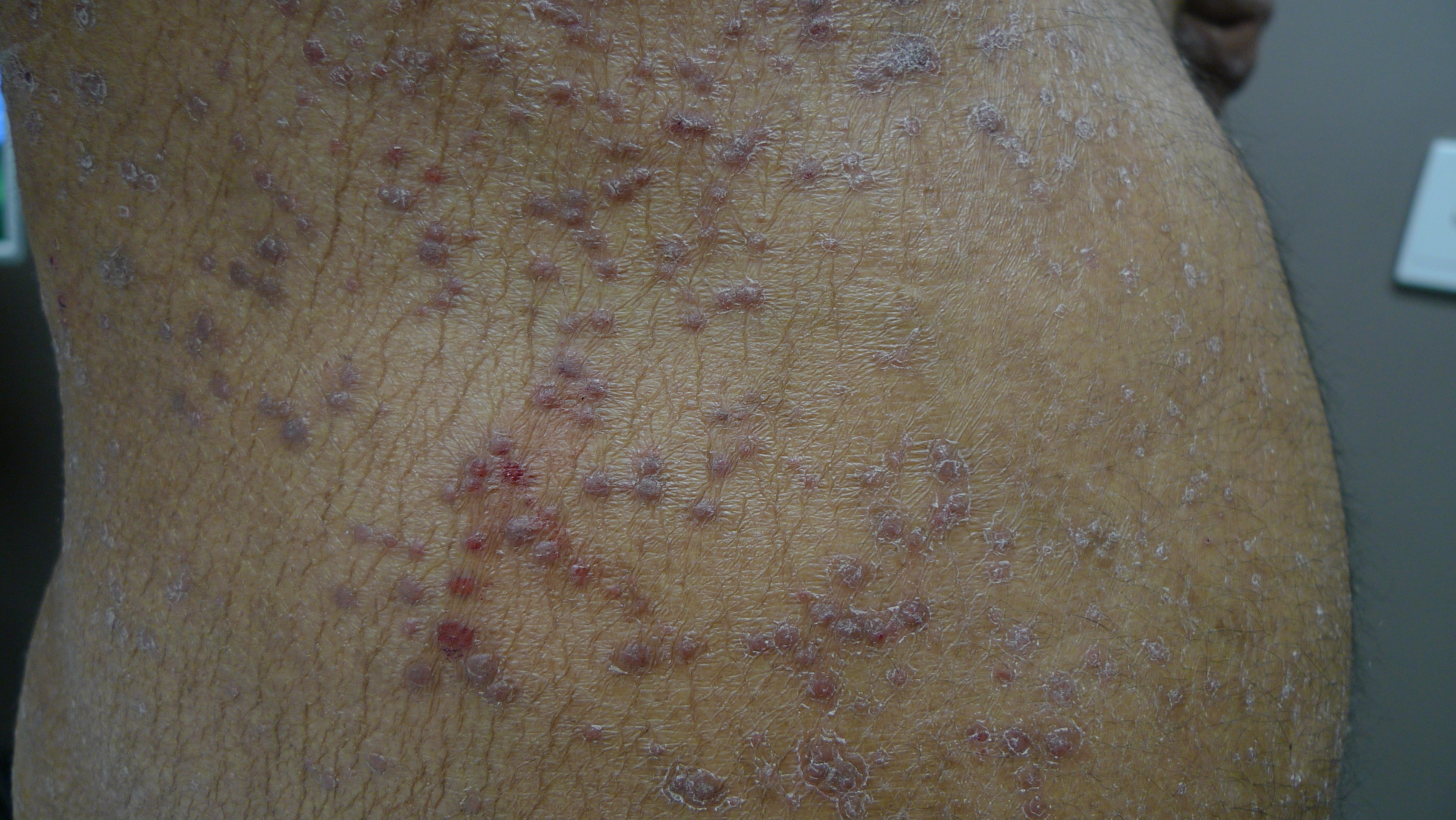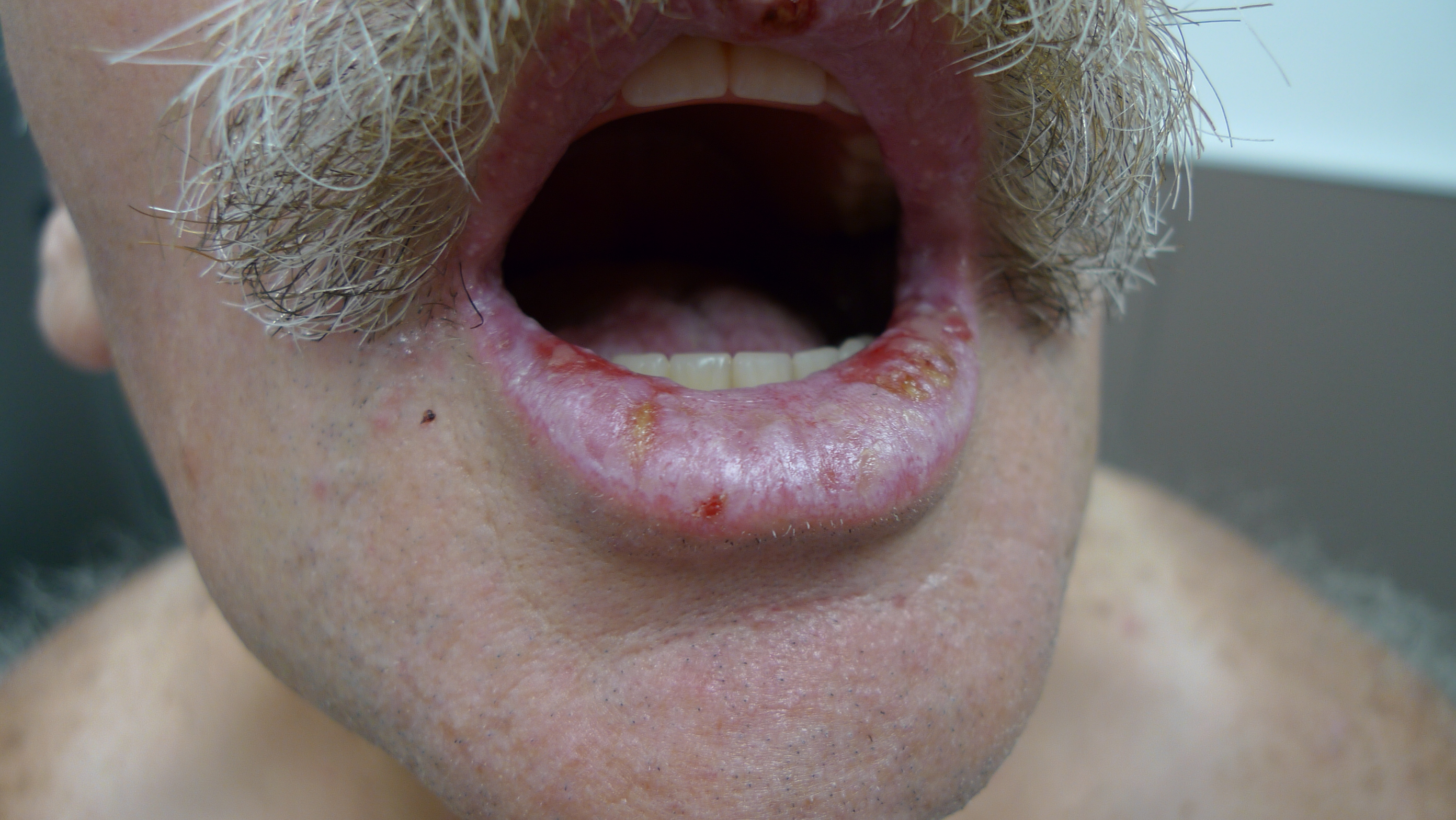Lichen planus
Also known as lichen ruber planus
What is lichen planus?
Lichen planus is a non-infectious, inflammatory skin condition, which generally occurs in middle-aged adults. It affects up to 1-2% of the population.

What causes lichen planus?
The cause of lichen planus is unknown but is thought to be due to an abnormal immune reaction (autoimmune disease). It occurs more frequently in those who are infected with hepatitis C; however, most people with lichen planus do not have hepatitis C.
Other rarer medical conditions that may be associated with lichen planus include: viruses such as human herpes virus 6 or 7 (HHV-6 or -7), herpes simplex virus (HSV), varicella zoster virus (VZV); bacteria such as the helicobacter pilori that can affect the stomach; vaccines and contact allergens such as amalgam teeth fillings; or other metals such as gold or copper.
A similar skin condition can be triggered by certain medications such as diuretics, ACE inhibitors, beta blockers, non steroidal anti-inflammatories, antimalarials and gold. The time interval from medication exposure to the appearance of the condition can vary from months to more than a year.
How is lichen planus diagnosed?
Lichen planus may be diagnosed based on its clinical appearance. However, a small sample of skin (skin biopsy) may be necessary in some cases to confirm the diagnosis.
What does lichen planus look like?
The most common form of the condition presents with 3 to 5 mm diameter, itchy, purple, flat-topped spots (papules) which when looked at closely, have irregular fine white streaks visible on the surface called “Wickham’s striae”. The number of lesions can vary from a few to many. They can join together to form lesions many centimetres in size called “plaques”. The areas typically affected are the fronts of the wrists, ankles and lower back although they can affect any part of the body surface. Skin trauma can promote formation of new lesions. This is called “the Koebner phenomenon”. When the spots resolve they generally leave brown stains called post-inflammatory hyperpigmentation which take months to resolve.

There are many forms of lichen planus. They can involve areas beyond the skin as listed below.
- Oral lichen planus
Oral lesions occur in 50% of those with skin involvement. In some cases, it is the only site of involvement. Oral lesions typically appear as lace-like white streaks on the inside of the cheeks (reticular pattern) but they can also affect the side of the tongue, gums and lips. An erosive form of oral lichen planus results in pain and ulceration which may lead to scarring. Some oral lesions may result from sensitivity to dental restorative materials or toothpaste. Oral lichen planus is a risk factor for oral squamous cell carcinoma, particularly the ulcerative type. In rare cases, it can involve other mucosal sites such as the eyes, nasal mucosa, larynx, oesophagus and anus.

- Nail lichen planus
Nail changes such as longitudinal grooves, ridges, nail plate thinning, thickening, roughness, nail lifting (onycholysis), nail loss (temporary or permanent) and nail bed scarring (pterygiums) occur in 10% of those with skin lesions.
- Genital lichen planus
Lesions can involve the glans penis in men and the vulva and vagina in women. Open sores called erosions can develop at these sites sometimes leading to ulceration, pain and scarring.
- Erosive lichen planus
A painful, ulcerative form of lichen planus can affect the inside of the cheek, side of the tongue, gums and inside of the lips, vulva, vagina and penis. Long standing erosive lichen planus can be complicated by squamous cell carcinoma.
- Scalp/follicular (lichen planopilaris and frontal fibrosing alopecia)
Lichen planus of the scalp and hair follicles can lead to permanent hair loss.
- Hypertrophic lichen planus
This is a thick, itchy, warty raised form of lichen planus which typically involves the shins.

- Annular lichen planus
Lichen planus papules form a ring with a central clearing, most commonly on the penis.
- Inverse lichen planus
This form of lichen planus tends to occur in the groin, armpits and under the breasts.
- Bullous lichen planus
This form of lichen planus is surmounted by blisters.
- Linear lichen planus
Linear lichen planus occurs in straight lines, possibly due to trauma (Koebner phenomenon) or it may occur in isolation.
- Lichen planus pigmentosus
This form of lichen planus is seen more commonly in the Middle East and India. Brown patches typically occur on the face, neck and upper limbs with some cases showing a tendency to affect the armpits.
- Actinic lichen planus
This form of lichen planus mostly occurs in people from India, the Middle East and East Africa. Brown patches with a surrounding white halo occur typically on the face.
How is lichen planus treated?
Mild cases may require no treatment.
Topical corticosteroids are first line therapy. They should be used as directed by your dermatologist as incorrect use can cause side effects. Creams should be applied to the itchy red/purple spots rather than the brown stains. Creams such as pimecrolimus or tacrolimus may be used instead of corticosteroids.
Intralesional corticosteroids may be used for thick and stubborn lesions.
Short term use of oral corticosteroids over a 6 week period may be used when lichen planus affects many areas of the body or oral lichen planus.
Light therapy (phototherapy) can be of benefit for widespread lichen planus.
Oral medications such as acitretin, hydroxychloroquine, methotrexate, cyclosporin and mycophenolate mofetil are sometimes used in particular cases.
What is the likely outcome of lichen planus?
Treatment helps control the condition but does not cure it. Most cases are self-resolving over 1 to 2 years regardless of treatment. Even after the condition has cleared, it leaves brown stains which can take many months to resolve. Oral, scalp and nail disease tends to be more persistent.
Drug induced lichen planus can take months to resolve after the medication causing the condition has been stopped.
This information has been written by Dr Glen Foxton
Updated 18 August 2015